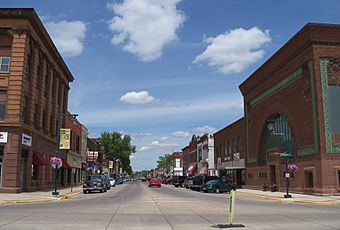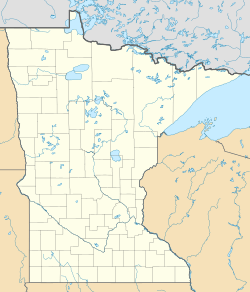Owatonna Commercial Historic District facts for kids
Quick facts for kids |
|
|
Owatonna Commercial Historic District
|
|

View up Cedar Avenue from Broadway Street
|
|
| Location | Roughly bounded by North Cedar Avenue, West & East Broadway, West Bridge & West Main Streets, Owatonna, Minnesota |
|---|---|
| Area | 21 acres (8.5 ha) |
| Built | 1871–1950s |
| Built by | Hammel Brothers and Anderson |
| Architect | Louis Sullivan, Frank A. Gutterson, Long and Long, Olof Hanson, T. Dudley Allen, William Keefe |
| Architectural style | Italianate, Romanesque Revival, Neoclassical, Commercial style, Sullivanesque |
| NRHP reference No. | 14001237 |
| Added to NRHP | February 2, 2015 |
The Owatonna Commercial Historic District is a special area in the historic downtown of Owatonna, Minnesota. It's like a time capsule showing how the city grew. This district includes 75 important buildings and one park. Most of these places were built between 1871 and the late 1950s.
This area was added to the National Register of Historic Places in 2015. This means it's recognized as an important part of history. It shows how Owatonna became a busy farming and industrial town. It also highlights its role as a "county seat," which is where the main government offices for the county are located.
What is the Owatonna Historic District?
The Owatonna Commercial Historic District covers parts of 12 city blocks. It's a place where you can see many old buildings. These buildings tell the story of Owatonna's past.
Why is This Area Special?
A big part of the district is Central Park, which was created in 1871. This park is a central spot for the whole area. It's surrounded by three very important buildings. These buildings were already famous on their own before the district was formed.
- The Steele County Courthouse was built in 1891. It's a grand building where local government decisions are made.
- The Owatonna City and Firemen's Hall dates back to 1907. This building once housed the city offices and the fire department.
- The National Farmer's Bank was built in 1908. It's known for its unique design by a famous architect.
In total, 74 buildings and Central Park itself are considered "contributing properties." This means they help make the district historically important. There are also 13 other buildings and two sites that are not considered "contributing." They are still part of the district but don't add to its historic value in the same way.
Images for kids




